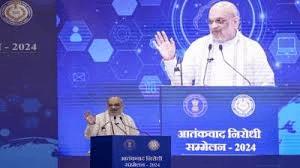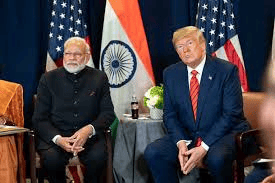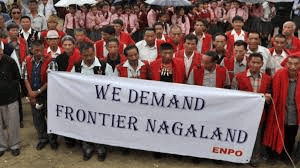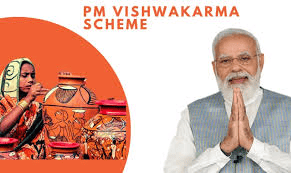UPSC Daily Current Affairs: 7th November 2024 | Current Affairs & Hindu Analysis: Daily, Weekly & Monthly PDF Download
GS2/Governance
Anti-terror conference 2024
Source: The Hindu

Why in News?
A two-day anti-terror conference 2024 in New Delhi will be inaugurated by the Union Home Minister. The event, hosted by the National Investigation Agency (NIA), aims to shape future counter-terrorism policies and strategies.
NIA has outlined major issues for an upcoming two-day anti-terror conference in New Delhi, including the role of organized crime in terror funding in northeast India, the use of encrypted apps, connections between organized criminal gangs and terrorism, and the regulation of social media in terror cases. These topics will be discussed with intelligence agency heads and state counter-terrorism squads.
Organised Crime and Terror Funding
About Organised Crime
- Organized crime consists of structured criminal enterprises that engage in illegal activities for profit.
- These organizations typically operate with a high degree of coordination, secrecy, and persistence, often using violence and corruption to maintain control over their activities.
- In India, examples of organized crime include drug trafficking, arms smuggling, human trafficking, extortion, and illegal mining.
Symbiosis between Organized Crime and Terrorism
- There exists a mutually beneficial relationship between organized crime and terrorist groups, allowing both to prosper.
- Terrorist organizations often depend on the financial support from organized criminal groups.
- Conversely, these criminal gangs gain protection and resources from the terrorist entities, enabling them to maintain their operations, especially in remote areas with limited government presence.
Role of Organized Crime in Terror Funding
- Organized crime and terrorism are interconnected in various ways, including:
- Illegal activities: Terrorist groups can fund their operations through illegal means such as drug trafficking, human trafficking, arms smuggling, extortion, smuggling, and kidnapping for ransom.
- Legal sources: Funding can also come from legal avenues including donations from wealthy benefactors, front organizations, and legitimate business activities.
- Money laundering: Criminals may exploit the financial system to facilitate terrorism through various methods including the formal financial system, new payment technologies like bitcoin, traditional value transfer methods like hawala, and trade-based money laundering.
Case Example: Northeast India
- In the northeastern states, especially Manipur, Nagaland, and Assam, insurgent groups have historically collaborated with organized crime.
- Groups like the United Liberation Front of Asom (ULFA) and the National Socialist Council of Nagaland (NSCN) are known to extort businesses, smuggle arms and drugs, and operate illegal taxation schemes.
- These activities provide essential funding for their insurgency efforts.
- Recent reports from the NIA indicate a rising trend of organized crime financing terrorism, with increasing cross-border smuggling and the proliferation of firearms worsening security challenges.
- The use of drones for smuggling drugs and weapons across the India-Myanmar border has also emerged as a significant concern.
Key Issues to Address at the Conference
- The two-day anti-terror conference organized by the NIA will focus on several critical issues, including:
- Terrorist Group Formation and Criminal Linkages: Emphasis on preventing new terrorist groups' formation through a stringent approach, as instructed by the Union Home Minister.
- Discussion about the role of organized crime in terror financing, particularly in northeast India.
- Exploration of the rise of Hizb-ut-Tahrir (HuT) in southern states and its connections to transnational crime syndicates.
- Case Studies and Emerging Threats: The agenda includes a detailed examination of the Rameshwaram cafe blast, highlighting the arrest of suspects through collaboration between West Bengal police and the NIA. It will also cover new methods for arms and drug trafficking using drones.
- Counter-Terrorism Coordination and Strategy: Discussions will focus on the need for a cohesive anti-terror framework, improving coordination among counter-terrorism units and local police at the district level, and strategies for tackling terror financing and dismantling terrorist networks in areas impacted by Left Wing Extremism.
- Technological Challenges in Terrorism: The role of social media and encrypted applications in facilitating terrorism, including the use of VPNs and virtual numbers by terrorist groups, as well as the impact of narcotics trafficking on national security.
- National Databases for Counter-Terrorism: Utilization of the NIA’s national terror database, which encompasses fingerprint records, terrorist case data, narco-offender records, and human trafficking information to support investigations.
GS2/International Relations
What Trump 2.0 mean for India?
Source:The Hindu

Why in News?
New Delhi’s enthusiastic reception of Trump 2.0 will be moderated by apprehensions about his social media posts and harsh stance on trade and tariffs.
Trump 2.0 Impact on India-U.S. Trade Relations:
- Trade Negotiations and Free Trade Agreement (FTA):Trump is expected to revive negotiations for an India-U.S. Free Trade Agreement (FTA) that started during his first term but were halted after his 2020 electoral defeat. This revival may offer opportunities for enhanced market access and trade collaborations.
- Focus on Tariffs:The Trump administration has consistently advocated for lowering trade tariffs, which might pressure India to reduce its own tariffs. This mirrors the situation during Trump 1.0, when India had to lower tariffs after counter-tariffs were imposed, resulting in India losing its Generalized System of Preferences (GSP) status.
- U.S. Military and Technology Access:India stands to gain increased access to U.S. military equipment and technology. The Trump administration has historically favored closer defense relationships with India, a trend that may continue and enhance India’s defense capabilities.
- Energy Deals and Trade:Trump may encourage India to boost its imports of U.S. oil and liquefied natural gas (LNG), similar to previous agreements such as the Driftwood LNG project. This could strengthen trade ties and position the U.S. as a significant energy partner for India.
Implications for India’s Foreign Policy (Russia and Iran):
- Relations with Russia:Trump’s favorable stance towards Russia suggests that India might encounter less pressure to reduce its ties with Moscow. Unlike previous U.S. administrations, Trump may adopt a more pragmatic stance, emphasizing strategic cooperation without urging India to sever its defense connections with Russia.
- Iran Policy:Given Trump’s earlier sanctions against Iran, India had to cut down its oil imports from Iran. With Trump 2.0, India is likely to face fewer sanctions-related pressures, as Trump has previously shown a more lenient approach towards Iran compared to his predecessors, allowing India to potentially restore or strengthen its relations with Iran.
Challenges from Trump’s Domestic Policies (Immigration and Technology Transfer):
- Immigration and H-1B Visa Policy:Trump’s stringent immigration policies and his stance on H-1B visas may create hurdles for India, especially concerning its skilled workforce. The Indian tech sector heavily relies on H-1B visas, and stricter regulations could limit opportunities for Indian professionals in the U.S., adversely impacting India’s IT and services sector.
- Technology Transfer:Trump’s inclination towards protectionism may hinder the transfer of advanced technologies to India, which could affect India’s ambitions to emerge as a global hub for high-tech industries, particularly in sectors like artificial intelligence, cybersecurity, and defense technology.
- Increased Focus on U.S. Jobs:Trump’s emphasis on reviving domestic jobs could result in policies favoring local industries over foreign partnerships, which may restrict opportunities for Indian companies in certain sectors and lead to trade tensions.
Way forward:
- Strengthen Bilateral Trade Negotiations:India should proactively participate in FTA discussions with the U.S., aiming for terms that benefit both sides while addressing tariff issues, market access, and defense collaboration, while also ensuring protections for sensitive sectors like technology and agriculture.
- Diversify Technology and Energy Partnerships:India ought to diversify its sources for technology transfer and energy imports, building relationships with other global players to mitigate potential risks from Trump’s protectionism, ensuring sustainable growth in high-tech industries and energy security.
Mains PYQ:
What is the significance of Indo-US defence deals over Indo-Russian defence deals? Discuss with reference to stability in the Indo-Pacific region.
GS2/Polity
The demand for greater autonomy for Eastern Nagaland districts
Source: Indian Express

Why in news?
Recently, the Nagaland government has expressed its readiness to provide feedback on the Centre's draft Memorandum of Settlement, which aims to grant greater autonomy to six eastern districts of the state after months of inactivity.
Historical Background
- The six eastern districts—Kiphire, Longleng, Mon, Noklak, Shamator, and Tuensang—have a unique historical context that has led to their demand for greater autonomy.
- These districts were administered differently after the formation of Nagaland from Assam in 1963, mainly due to their limited infrastructure and resources.
16-Point Agreement & Article 371(A)
- Article 371(A) provides special provisions for Nagaland, aiming to safeguard Naga customs and address specific issues in the Tuensang region, which encompasses these districts.
- A regional council was initially established to govern these areas, acknowledging their unique needs.
Development Deficit
- Despite the special provisions, these districts continue to struggle with significant development challenges, including poor infrastructure, healthcare, and education.
- This ongoing development deficit has intensified calls for separate governance, as the current state administration is seen as neglecting their needs.
Proposed 'Frontier Nagaland Territory'
- This new model of autonomy would introduce a separate legislature, executive, and financial powers for the region, granting it enhanced local governance.
- A regional council would address local issues, expanding upon the powers outlined in Article 371(A).
- An independent headquarters in East Nagaland would provide local leaders more direct control over administrative matters, as opposed to the current centralization in Kohima.
Role of Local Organizations (ENPO)
- The Eastern Nagaland People's Organization (ENPO) has been a key advocate for autonomy since its memorandum to the Prime Minister's Office in 2010.
- ENPO's strategies include boycotting elections to pressure both state and central governments, highlighting the urgency of their demands.
- They insist on negotiating autonomy directly with the central government, indicating dissatisfaction with the state administration's approach to Eastern Nagaland's issues.
Government Responses
- The central government has shown some openness to a "mutually agreed solution," as indicated by the draft Memorandum of Settlement and previous commitments to ENPO.
- The state government, after an initial delay, has agreed to submit its views on the proposal to mitigate regional unrest.
- Both governments will likely engage in negotiations to balance autonomy demands with the broader interests of Nagaland, aiming to address developmental issues without leading to full separation.
Way Forward
- There is a need to enhance local governance and infrastructure, establishing a framework that allows for dedicated funds and authority to address the developmental challenges faced by Eastern Nagaland.
- Regular and inclusive dialogues should occur among the Centre, state government, ENPO, and local representatives to ensure transparent and collaborative resolutions to ongoing concerns.
GS2/Polity
Cabinet Approves ₹3,600 Crore PM Vidyalaxmi Scheme
Source:Hindustan Times

Why in news?
The Union Cabinet, under Prime Minister Narendra Modi, has initiated the PM Vidyalaxmi Scheme, a significant Central Sector initiative aimed at providing financial support to deserving students, enabling them to pursue higher education without facing economic barriers. This initiative aligns with the goals set forth in the National Education Policy, 2020, which emphasizes the need for financial assistance for students in both public and private Higher Education Institutions (HEIs).
Objectives of the Scheme:
- Ensure Financial Inclusion in Education: Facilitate access to higher education for meritorious students without financial obstacles.
- Support Top Educational Institutions: The scheme is designed for top-ranked HEIs according to the National Institutional Ranking Framework (NIRF).
- Provide Transparent and Digital Access: Implement a fully digital, transparent, and user-friendly platform for processing and managing loans.
Key Features of the Scheme:
Loan Availability
- Eligibility: Any student securing admission to a Quality Higher Education Institution (QHEI) can apply.
- Loan Terms: Loans will be offered without collateral or a guarantor, covering full tuition and related expenses.
- Institutional Coverage: Applicable to institutions in the top 100 NIRF rankings and state government HEIs ranked 101-200, including all central government institutions.
- Coverage Scope: Initially, 860 QHEIs are included, potentially benefiting over 22 lakh students.
- Credit Guarantee Support: A 75% credit guarantee is available for loans up to ₹7.5 lakhs, encouraging banks to provide education loans more readily.
- Interest Subsidy: Students from families with annual incomes up to ₹8 lakhs, not receiving other scholarships, are eligible for a 3% interest subvention on loans up to ₹10 lakhs during the moratorium.
- Beneficiary Priority: Preference will be given to students enrolled in government institutions and technical/professional courses.
Budget and Reach:
- An allocation of ₹3,600 crore is designated for the years 2024-25 to 2030-31, aiming to provide interest subvention benefits to 1 lakh students annually, totaling 7 lakh students over the scheme's duration.
Unified Digital Platform:
- The “PM Vidyalaxmi” portal, overseen by the Department of Higher Education, will streamline the application process for education loans and interest subvention.
- Payments will be facilitated through E-vouchers and Central Bank Digital Currency (CBDC) wallets, ensuring secure and efficient fund transfers.
Supplementary Government Schemes:
- The PM Vidyalaxmi Scheme is complementary to the PM-USP (Prime Minister’s Unique Scholarship Program) and the Central Sector Interest Subsidy Scheme (CSIS).
- The CSIS provides full interest subvention during the moratorium for loans up to ₹10 lakhs for students from families earning up to ₹4.5 lakhs, specifically for technical/professional courses at approved institutions.
- The Credit Guarantee Fund Scheme for Education Loans (CGFSEL) supports education loans with a guarantee fund.
- Together, these initiatives create a comprehensive financial support system for eligible students, enabling access to quality higher education and technical training at premier institutions.
GS3/Environment
Development of Tuna Cluster in Andaman and Nicobar Islands
Source: Indian Education Diary

Why in News?
The Department of Fisheries has announced the establishment of a Tuna Cluster as part of the Pradhan Mantri Matsya Sampada Yojana (PMMSY). The Andaman and Nicobar Islands present considerable potential for fisheries development, with an Exclusive Economic Zone (EEZ) spanning approximately 6.0 lakh square kilometers. This area is abundant in marine resources, particularly various species of tuna, with an estimated harvest potential of 60,000 metric tons. The strategic location of these islands near Southeast Asia facilitates efficient maritime and aerial trade, while the pristine waters are conducive to sustainable fishing practices.
About Tuna Species and its Significance
- Tuna are large, agile fish belonging to the Thunnini tribe within the Scombridae family.
- Known for their streamlined bodies, tuna are distributed across tropical and temperate oceans globally.
- There are over 15 species of tuna, including well-known types such as Bluefin, Yellowfin, Albacore, Bigeye, and Skipjack.
- Tuna have a rapid growth rate and can live for several decades, with Bluefin tuna capable of exceeding 450 kg in weight.
- These fish are among the most sought-after and valuable in the global seafood market due to their desirable flavor, texture, and nutritional profile.
- Species like Bluefin tuna are particularly prized, often commanding high prices in markets, especially in Japan, where they are used in sushi and sashimi.
- Tuna are rich in protein, low in saturated fat, and packed with omega-3 fatty acids, which are beneficial for heart health, brain function, and reducing inflammation.
- They also provide essential vitamins and minerals, including Vitamin D, B12, iron, and selenium.
Back2Basics:
PM Matsya Sampada Yojana
- Aim: To promote the Blue Revolution in India's fisheries sector.
- Investment: Rs. 20,050 crores allocated over five years (FY 2020-21 to FY 2024-25) under the Aatmanirbhar Bharat Package.
- Fish Production: Target to increase fish production by an additional 70 lakh tonnes by 2024-25.
- Export Earnings: Aim to elevate fisheries export earnings to Rs. 1,00,000 crore by 2024-25.
- Income Doubling: Initiative to double the incomes of fishers and fish farmers.
- Post-Harvest Losses: Goal to reduce post-harvest losses from 20-25% to approximately 10%.
- Employment Generation: Focus on creating significant job opportunities within the fisheries sector.
Aims and Objectives
- Ensure sustainable and equitable development in fisheries.
- Enhance productivity through diversification of fish species and practices.
- Modernize the fisheries value chain.
- Boost exports of fish and fish products.
- Guarantee security and support for fishing communities.
- Implement effective management strategies for resources.
Implementation Components
- Consists of a Central Sector Scheme and Centrally Sponsored Scheme with substantial involvement from state governments.
Implementation Approach
- Adopts a structured framework and a cluster-based strategy to achieve optimal results.
GS2/Governance
NEW COASTAL ZONE PLAN OF KERALA
Source: The Hindu

Why in news?
The Union Ministry of Environment, Forest and Climate Change has granted approval for the Coastal Zone Management Plan (CZMP) for ten coastal districts in Kerala.
Background:
- The CZMP has been developed in accordance with the guidelines established by the Coastal Regulation Zone Notification of 2019, allowing coastal districts to benefit from more lenient CRZ rules, thereby enabling various development projects, including the construction of buildings towards the sea.
Key takeaways
- A Coastal Zone Management Plan (CZMP) serves as a framework to manage and regulate activities in coastal areas, aiming to harmonize environmental preservation with sustainable development.
- In India, the Ministry of Environment, Forest and Climate Change (MoEF&CC) introduced the Coastal Regulation Zone (CRZ) Notification in 2019, which requires coastal states and Union Territories to create CZMPs.
Key Objectives of CZMPs:
- Environmental Conservation:Aims to protect sensitive ecological regions such as mangroves, coral reefs, and habitats for wildlife.
- Sustainable Development:Encourages development initiatives that do not harm the health of coastal ecosystems.
- Livelihood Security:Ensures the protection of the rights and interests of coastal communities, particularly fisherfolk.
Components of a CZMP:
- Demarcation of Coastal Zones:Involves identifying and categorizing coastal areas into various zones (e.g., CRZ-I, CRZ-II, CRZ-III, CRZ-IV).
- Regulatory Measures:Establishes guidelines and restrictions for allowed activities within each zone to avert environmental harm.
- Management Strategies:Formulates plans for pollution control, disaster preparedness, and conservation of coastal and marine resources.
What does it mean for Kerala?
- Kerala has a coastline stretching approximately 590 km, with nine out of fourteen districts located along the Arabian Sea.
- According to the 2011 Census, Kerala has a population density of 859 individuals per square kilometer, significantly surpassing the national average of 382 per square kilometer. The coastal regions specifically exhibit a much higher population density compared to inland areas.
- The high population concentration has led to numerous violations of CRZ regulations along the coast. The previous CRZ regime, effective until the CZMP's approval, prioritized the preservation of coastal ecosystems, which is crucial for the livelihoods of millions of fishers and coastal inhabitants.
What are the benefits?
- The CZMP's approval is expected to directly benefit around 1 million people, as it relaxes previous restrictions on constructing new homes and repairing existing ones.
- The new regulations will decrease the No Development Zone (NDZ) around tidal-influenced water bodies, allowing for more development.
- For example, 37 village panchayats will now be categorized as CRZ-III A, where the NDZ has been reduced to one-fourth of what it was under the previous regime. In these densely populated rural areas, the 2011 Census recorded a population density of 2,161 per square kilometer, with the NDZ being set at 50 meters from the High Tide Line, compared to the 200 meters mandated by the 2011 CRZ notification.
What about mangroves?
- The 2019 notification has reduced the legal protections for government-owned mangrove areas exceeding 1,000 square meters to a mere 50-meter buffer zone.
- Additionally, the new regulations have eliminated the mandatory buffer zones around mangrove areas located on private property, rendering vast expanses of mangrove vegetation vulnerable to exploitation.
GS2/Governance
POSITIVE SECULARISM
Source:Indian Express

Why in News?
The Supreme Court in the case of Anjum Qadri and Anr vs Union of India & Ors upheld the constitutionality of the UP Madarsa Act, 2004. The Allahabad High Court had previously ruled the UP Madarsa Education Board Act as “unconstitutional” on March 22 this year. However, the Supreme Court did not concur with the High Court's decision to annul the Madarsa Act on the grounds of secularism being part of the Basic Structure of the Constitution.
- The Supreme Court referred to its earlier judgment in Indira Nehru Gandhi (1975), stating that the Basic Structure doctrine should be applied to assess the validity of constitutional amendments, not ordinary legislation like the UP Madarsa Act.
- Chief Justice Chandrachud, in the current ruling, indicated that when evaluating an ordinary law, courts must consider legislative competence and alignment with fundamental rights.
- The judgment clarified that an ordinary law cannot be deemed unconstitutional for infringing upon the basic structure of the Constitution, as concepts like democracy, federalism, and secularism lack clear definitions.
- Allowing courts to invalidate legislation based on violations of such ambiguous concepts could lead to judicial unpredictability.
- Since the Madarsa Act was struck down citing secularism, the judgment extensively analyzed this concept, referencing the nine-judge bench ruling in S R Bommai v. Union of India (1994), which established secularism as a positive principle involving equal treatment of all religions.
Key Aspects of Secularism Addressed
- The Supreme Court noted that Articles 25 to 30 of the Constitution represent another dimension of secularism, emphasizing the state's role in fostering religious tolerance.
- By recognizing and regulating Madarsa education, the state legislature acts positively to protect the educational rights of minority communities.
- The court asserted that secularism embodies a principle of equality, stating that true substantive equality cannot be achieved unless the state is actively engaged in ensuring equal treatment for all individuals, regardless of their religious affiliations.
Minority Institutions and State Regulations
- The court referenced its significant rulings related to Article 30 to clarify the limitations of state control over minority institutions under the guise of regulation.
- It emphasized that the minority status of an institution must not be compromised or eliminated; while minorities do not possess an inherent right to government aid or official recognition, such support must not undermine the institution's minority identity.
- Madarsas have the right to state protection under Article 26, which allows religious denominations to establish and maintain institutions for religious and charitable purposes, legitimizing the establishment of purely religious institutions.
GS2/Governance
PM VISHWAKARMA SCHEME
Source:Business Today

Why in news?
The Government has announced that over 25 million applications have been received under the PM Vishwakarma Scheme since its inception. Out of these, more than 2 million applicants have successfully completed the registration process, which involves a rigorous three-step verification. The Ministry of Micro, Small and Medium Enterprises (MSME) has noted that the scheme has attracted significant interest.
- The PM Vishwakarma Scheme is a Central Sector initiative launched by the Ministry of MSME on September 17, 2023. Its primary goal is to offer extensive support to traditional artisans and craftspeople, collectively known as 'Vishwakarmas', to enhance their skills, tools, and market access.
This scheme caters to artisans and craftspeople involved in 18 different trades, including:
- Carpenter (Suthar/Badhai)
- Boat Maker
- Armourer
- Blacksmith (Lohar)
- Hammer and Tool Kit Maker
- Locksmith
- Goldsmith (Sonar)
- Potter (Kumhaar)
- Sculptor (Moortikar, stone carver)
- Stone breaker
- Cobbler (Charmkar)/ Shoesmith/Footwear artisan
- Mason (Rajmistri)
- Basket/Mat/Broom Maker/Coir Weaver
- Doll & Toy Maker (Traditional)
- Barber (Naai)
- Garland maker (Malakaar)
- Washerman (Dhobi)
- Tailor (Darzi)
- Fishing Net Maker
Key Features of the Scheme:
- Recognition and Certification: Artisans receive a PM Vishwakarma certificate and ID card, which acknowledges their skills and contributions.
- Skill Upgradation: The scheme provides basic training lasting 5-7 days and advanced training for 15 days or more, offering a stipend of ₹500 per day to enhance artisans’ proficiency.
- Toolkit Incentive: An incentive of up to ₹15,000 is available in the form of e-vouchers, which artisans can use to acquire modern tools at the start of their basic skill training.
- Credit Support: The scheme facilitates collateral-free loans disbursed in two phases: up to ₹1 lakh in the first phase and up to ₹2 lakh in the second phase, with a concessional interest rate of 5%.
- Digital Transactions Incentive: To promote financial inclusion, the scheme encourages artisans to adopt digital payments by providing incentives.
- Marketing Support: Artisans will receive marketing assistance, including quality certification, branding, and support for onboarding on e-commerce platforms like GeM, as well as advertising and publicity efforts to enhance their market reach.
GS3/Health
How Vitamin D deficiency can trigger autoimmune conditions?
Source:Times of India

Why in News?
Recent studies from McGill University have highlighted the important role of vitamin D in maintaining the health of the thymus gland, which is crucial for proper immune function.
About Autoimmune Conditions:
- Autoimmune conditions are disorders where the immune system erroneously attacks the body's own healthy tissues, mistaking them for foreign invaders.
- Vitamin D is significant for regulating immune responses and fostering immune tolerance, which is the body’s ability to avoid damaging its own cells.
- This vitamin influences T-cells, a type of immune cell, guiding them to recognize and accept the body’s own tissues instead of attacking them.
- The thymus gland plays a vital role in training T-cells to avoid harming healthy cells. A deficiency in vitamin D can lead to premature aging of the thymus, impairing its capability to effectively regulate T-cells.
- Vitamin D also impacts various genetic pathways associated with immune function. Variations in the vitamin D receptor (VDR) gene may increase susceptibility to autoimmune diseases, making certain individuals more sensitive to vitamin D levels.
What is Vitamin D?
- Vitamin D is a fat-soluble vitamin essential for the body’s absorption of calcium, magnesium, and phosphate, all of which are vital for maintaining bone health.
- It supports muscle movement, nerve function, and overall bodily responses. Given its production in the skin upon exposure to sunlight, it is often referred to as the "sunshine vitamin."
- The body synthesizes vitamin D when skin is exposed to ultraviolet B (UVB) rays from sunlight.
Sources of Vitamin D:
- Fish: Fatty fish like salmon, mackerel, tuna, and sardines are excellent sources of vitamin D.
Cod liver oil: This concentrated source provides between 400 and 1,000 IU of vitamin D per teaspoon.
- Mushrooms: Varieties such as portobello can produce vitamin D when exposed to UV light.
- Fortified Foods: Many foods like milk, yogurt, orange juice, and cereals are fortified with added vitamin D.
- Egg yolks: These contain a small quantity of vitamin D.
- Common forms of vitamin D include vitamin D2 (ergocalciferol) and vitamin D3 (cholecalciferol), which are particularly beneficial during autumn and winter when sunlight exposure is reduced.
Significance of Vitamin D:
- Bone Health: Vital for calcium absorption, thus strengthening bones and preventing osteoporosis.
- Muscle and Nerve Function: Supports muscle contractions and nerve signaling between the brain and body.
- Immune System: Boosts immune defenses, aiding in the fight against infections caused by viruses and bacteria.
- Brain Health: May assist in maintaining cognitive health, particularly in older adults.
- Inflammation and Pain: Regulates the body's response to inflammation and pain.
- Blood Pressure: Linked to the regulation of blood pressure; deficiency can be related to hypertension.
Impacts of Vitamin D Deficiency:
- Deficiency increases the risk of rickets in children, leading to softening of bones, and can also affect adults.
- Low vitamin D levels are associated with autoimmune conditions such as rheumatoid arthritis, lupus, and multiple sclerosis.
- Recent research suggests that a lack of vitamin D can speed up thymus aging, resulting in immune system dysfunction and a heightened risk of autoimmune diseases.
- Deficiency has also been linked to other serious health issues including cancer, cardiovascular disease, diabetes, depression, and chronic pain.
- Symptoms of deficiency may include fatigue, muscle weakness, and bone pain.
- In severe instances, it may lead to impaired bone growth and increased susceptibility to fractures.
|
38 videos|5288 docs|1117 tests
|





















